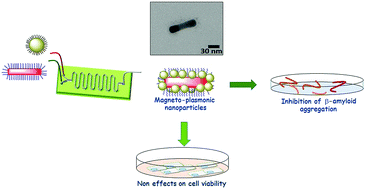Peptide functionalized magneto-plasmonic nanoparticles obtained by microfluidics for inhibition of β-amyloid aggregation†
Abstract
In the present work, we report on the synthesis of peptide functionalized magneto-plasmonic nanoparticles in a simple microfluidic platform. Superparamagnetic nanoparticles and gold nanorods were selected for this study. Magnetic nanoparticles were functionalized with peptide D1, which can bind selectively to toxic aggregates of the β-amyloid peptide associated with Alzheimer's disease. Gold nanorods were functionalized with chitosan replacing the surfactant cetyltrimethylammonium bromide to reduce the cytotoxic effect. The selected microfluidic strategy yields structures with plasmonic and magnetic properties in a nanostructure. Cytotoxic assays with SH-SY5Y cells demonstrate that nanoparticles obtained by microfluidics do not affect cell viability at the studied concentrations. Additionally, these magneto-plasmonic nanoparticles inhibit fibril formation demonstrating that the magneto-plasmonic nanoparticles obtained by microfluidics could be applied for a potential treatment and diagnosis of Alzheimer's disease.



 Please wait while we load your content...
Please wait while we load your content...